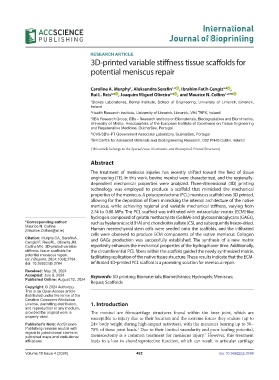Page 500 - IJB-10-4
P. 500
International
Journal of Bioprinting
RESEARCH ARTICLE
3D-printed variable stiffness tissue scaffolds for
potential meniscus repair
Caroline A. Murphy , Aleksandra Serafin 1,2 id , Ibrahim Fatih Cengiz 3,4 id ,
1
*
Rui L. Reis 3,4 id , Joaquim Miguel Oliveira 3,4 id , and Maurice N. Collins 1,2,5 id
1 Stokes Laboratories, Bernal Institute, School of Engineering, University of Limerick, Limerick,
Ireland
2 Health Research Institute, University of Limerick, Limerick, V94 T9PX, Ireland
3 3B’s Research Group, I3Bs – Research Institute on Biomaterials, Biodegradables and Biomimetics,
University of Minho, Headquarters of the European Institute of Excellence on Tissue Engineering
and Regenerative Medicine, Guimarães, Portugal
4 ICVS/3B’s–PT Government Associate Laboratory, Guimarães, Portugal
5 SFI Centre for Advanced Materials and BioEngineering Research, D02 PN40 Dublin, Ireland
(This article belongs to the Special Issue: Biomimetic and Bioinspired Printed Structures)
Abstract
The treatment of meniscus injuries has recently shifted toward the field of tissue
engineering (TE). In this work, bovine menisci were characterized, and the regionally-
dependent mechanical properties were analyzed. Three-dimensional (3D) printing
technology was employed to produce a scaffold that mimicked the mechanical
properties of the meniscus. A polycaprolactone (PCL) meniscus scaffold was 3D printed,
allowing for the deposition of fibers mimicking the internal architecture of the native
meniscus, while achieving regional and variable mechanical stiffness, varying from
2.74 to 0.88 MPa. The PCL scaffold was infiltrated with extracellular matrix (ECM)-like
hydrogels composed of gelatin methacrylate (GelMA) and glycosaminoglycans (GAGs),
*Corresponding author: such as hyaluronic acid (HA) and chondroitin sulfate (CS), and subsequently freeze-dried.
Maurice N. Collins Human mesenchymal stem cells were seeded onto the scaffolds, and the infiltrated
(Maurice.Collins@ul.ie)
cells were observed to produce ECM components of the native meniscus. Collagen
Citation: Murphy CA, SerafinA, and GAGs production was successfully established. The synthesis of a new matrix
Cengiz IF, Reis RL, Oliveira JM,
Collins MN. 3D-printed variable reportedly enhances the mechanical properties of the hydrogel over time. Additionally,
stiffness tissue scaffolds for the circumferential PCL fibers within the scaffold guided the newly synthesized matrix,
potential meniscus repair. facilitating replication of the native tissue structure. These results indicate that the ECM-
Int J Bioprint. 2024;10(4):3784.
doi: 10.36922/ijb.3784 infiltrated 3D-printed PCL scaffold is a promising solution for meniscus repair.
Received: May 29, 2024
Accepted: July 9, 2024 Keywords: 3D printing; Biomaterials; Biomechanics; Hydrogels; Meniscus;
Published Online: August 12, 2024
Repair; Scaffolds
Copyright: © 2024 Author(s).
This is an Open Access article
distributed under the terms of the
Creative Commons Attribution
License, permitting distribution, 1. Introduction
and reproduction in any medium,
provided the original work is The menisci are fibrocartilage structures found within the knee joint, which are
properly cited. susceptible to injury due to their location and the extreme forces they endure (up to
Publisher’s Note: AccScience 24× body weight during high-impact activities), with the meniscus bearing up to 50–
Publishing remains neutral with 70% of these joint loads. Due to their limited vascularity and poor healing potential,
1
regard to jurisdictional claims in 2
published maps and institutional meniscectomy is a common treatment for meniscus injury. However, this treatment
affiliations. leads to a loss in chondroprotective function, which can result in articular cartilage
Volume 10 Issue 4 (2024) 492 doi: 10.36922/ijb.3784

